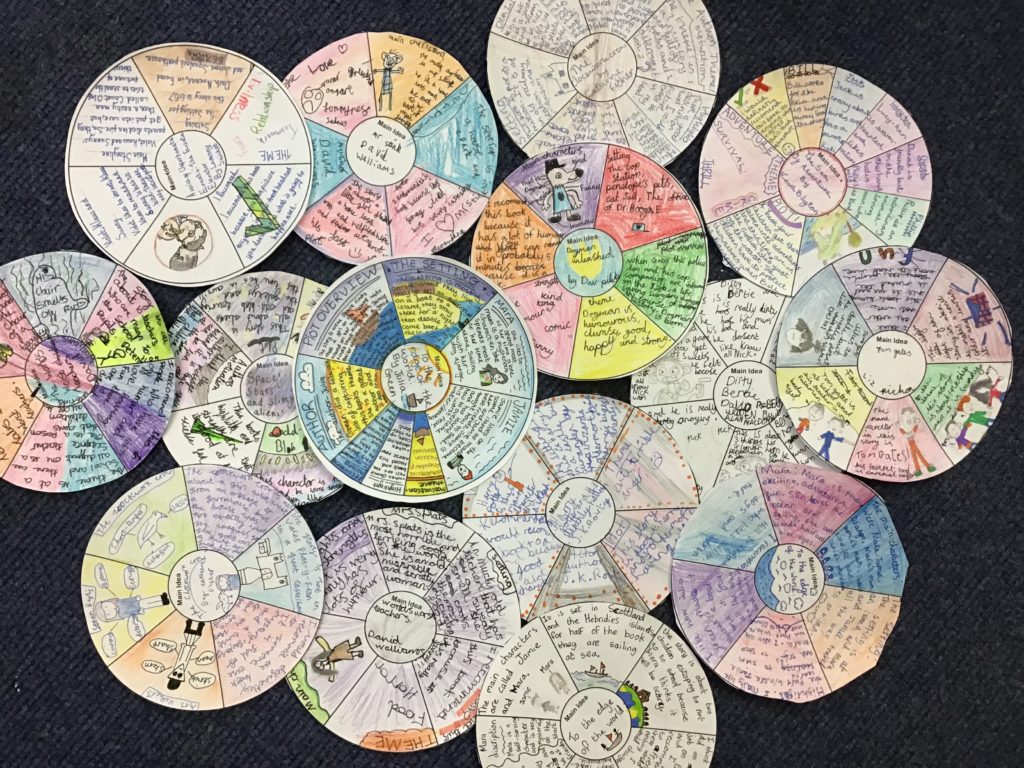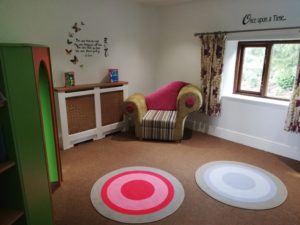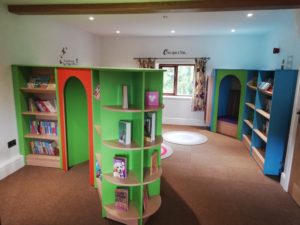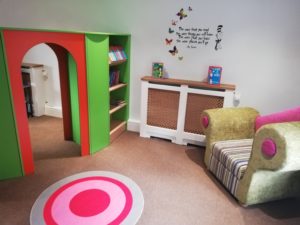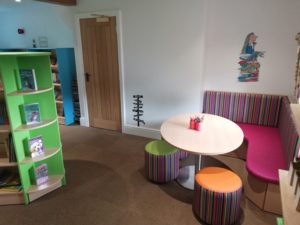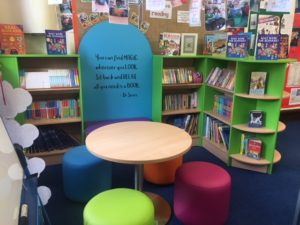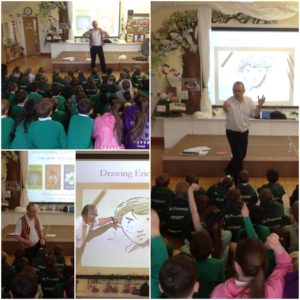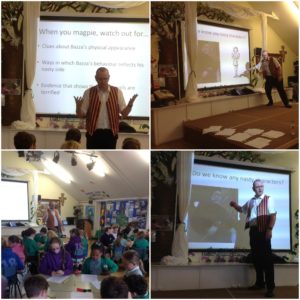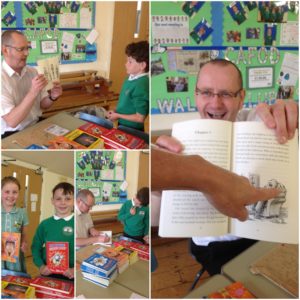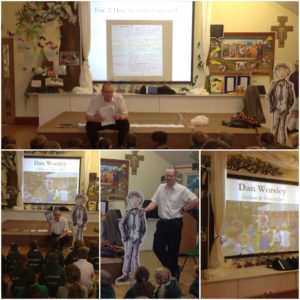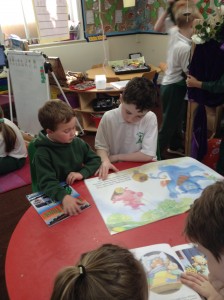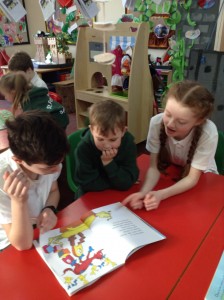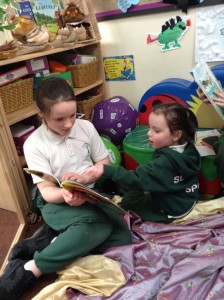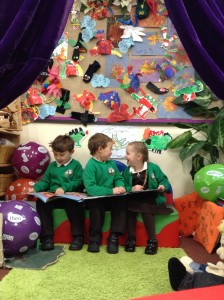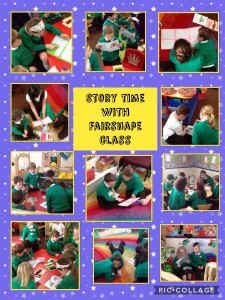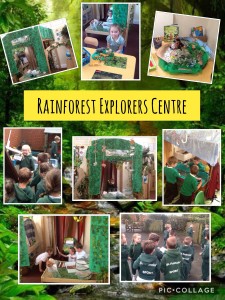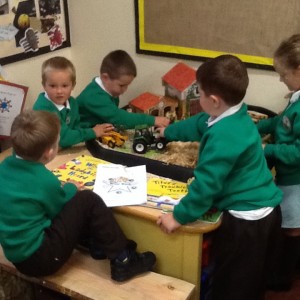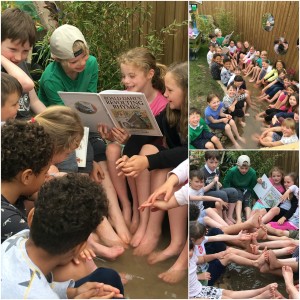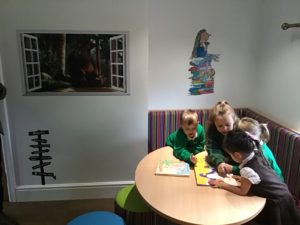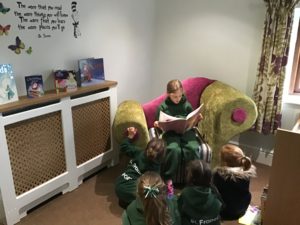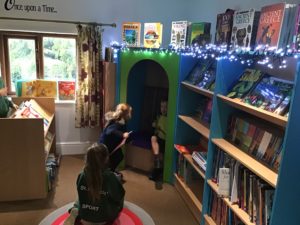Phonics and Early Reading
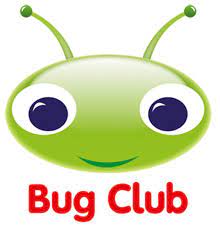
As a school, we teach reading and phonics from Reception Class and we use Bug Club programme and books to embed phonics. We also have online Bug Club for children to enjoy using and applying their phonics skills at home.
We teach rigorous and systematic teaching of synthetic phonics from the beginning of Reception, starting with the easiest sounds, and progressing to the most complex, reading and writing simple words and tricky words along the way. The sequence of reading books follows a cumulative progression in phonics knowledge, with frequent and detailed assessment used to identify any child falling behind the pace of our school’s phonics programme, so that they can be offered targeted support to address any gaps right away.
Our reading books closely match the phonics knowledge that pupils are being taught and we offer children plenty of opportunities to practice reading and re-reading the grapheme-phoneme correspondences that they have learned – both at school and at home. Children hear a wide range of texts read aloud in the classroom, including stories, poems, rhymes and non-fiction to develop their vocabulary, language comprehension and love of reading. We have a huge emphasis on children being authors themselves and work is published and kept in classroom reading areas to promote a purpose for writing and enjoyment of reading. Teachers read to children in class every day.
Why_learn_the_High_Frequency_Words
At St. Francis’ children are immersed in literacy in all areas of the curriculum and school life. Whilst your child may not be “heard” to read everyday they will be reading throughout the day, as well as developing important speaking and listening skills. Your children have access to word games, focused letters and sound games, online reading games and activities and much more. Please ask in school if you want to find out more. Each year, we invite you all in for a phonics and reading workshop to explain the process.
We use the Pearson Bug Club in school. Progression is based on Book Bands and we pride ourselves on giving our children the opportunity to progress by providing a wide range of genres from a variety of publishers in order to inspire and engage our children’s imaginations.
Each child is assigned a book within their reading level. Children can change their home reading book on a daily basis and choose these themselves from the book banded baskets in class libraries.
We encourage reading at home and you have access to reading records which provide the opportunity for parents to share their thoughts. This is a great way of communicating and every time you sign the reading diary, your child gets a sticker on their very own bookmark. When a bookmark is full, your child is awarded with a certificate in assembly. It is important that you hear your child read every night and discussion about the texts plays an important role in your child developing comprehension skills.
Books are given based on ability, ranging from high quality picture books, early first word and progression through the phonic phases.
We approach the teaching of reading in a structured way incorporating synthetic phonics with guided and independent reading based on book bands.
Guided reading provides an opportunity for the teacher to teach reading in relation to the differentiated needs of the pupil groups and their level of achievement. The grouping of children is closely monitored and children are assessed regularly to check on progress.
Children will be supported to learn the first 100, then 200 high frequency words. These will be the common words you will see in their early reading books from Reception to Year 2.
HAVE FUN READING!
We love reading and children are read to every day by their teachers. Books are at the heart of our curriculum maps and we encourage children to take books home from our class libraries, as well as our guided reading books and reading scheme books to take home. We celebrate national events such as World Book Day, Pyjamarama (a Booktrust charity initiative to help every child get a bedtime story), We are Reading (LCC event), our own extreme reading competition, national poetry day and more! We welcome author visits, have virtual author visits and we publish our own work for others to read. Every fortnight, Miss Deakin listens to Reception children read and she also listens to the whole school on a regular basis. All children have a sticker bookmark to fill up every time they read at home-a full bookmark means being presented with a reading certificate in assembly!
Intent:
The study of English develops children’s abilities to listen, speak, read and write for a wide range of purposes, so using language to learn and communicate ideas, views and feelings. It enables children to express themselves creatively and imaginatively, as they become enthusiastic and critical readers of stories, poetry and drama, as well as non-fiction and media texts. Children gain an understanding of how language works by looking at its patterns, structures and origins. Children use their knowledge, skills and understanding in speaking and writing across a range of different situations. We want all children to read fluently and with good understanding and to read for pleasure and information. We strive to instil a passion for reading in pupils, which they will carry on into subsequent phases of education and into later life.
We aim for all children to:
- read easily, fluently and with good understanding
- develop the habit of reading widely and often, for both pleasure and information
- acquire a wide vocabulary, an understanding of grammar and knowledge of linguistic conventions for reading, writing and spoken language
Throughout school, you will find many beautiful reading areas for children to relax and enjoy reading together:
The journey begins
Phonics to fluency and the gateway of wider learning…
How do we prioritise reading?
- Each of our classrooms has a bespoke reading area where pupils can sit comfortably during the day to read a book. The areas have props, high interest books and non-fiction materials and children create class anthologies to be read by other children in the reading areas. We publish our own stories and write for a purpose, knowing that our writing will be displayed in the reading areas and shared with others.
- Author visits, virtual author visits and engaging with authors helps us to appreciate a love of books.
- At the entrance to school, we have a little free library and children can swap books and take them home to keep.
- We have an outdoor reading shed in the EYFS and KS1 outdoor area and children are encouraged to share books with one another.
- Books in class and all reading areas are changed regularly to ensure high interest.
- Books are diverse and inspiring for children, preparing children for cultural capital.
- The head teacher has a story time section on the website.
- Beautiful libraries are a looked after space in all classrooms.
- The headteacher reads with EYFS and infant children every fortnight.
- Weekly assemblies serve to celebrate and encourage reading. Every child in school has a sticker bookmark and children are given a sticker each time they read at home. When a bookmark is complete, the headteacher presents the child with a reading certificate in the Star Award assembly.
- We take part in National and County events eg, World Book Day, Extreme Reading, Pyjamarama.
- We use enjoyment of texts within our positive behaviour management systems: Shout an extract from a text and children respond by expressively saying the next line-emphasis on developing vocabulary and understanding.
- In our writing units of work, we begin by immersing children in a reading phase, studying a variety or texts.
- EYFS snuggle sacks are sent home for children to read for pleasure with their families-with a hot chocolate!
- Children are read to every day.
- Cross-curricular guided reading books and non –fiction history, geography and science books, graphic novels, play scripts and poetry books support prior learning and engage children’s interests.
How do we teach phonics from the start?
- At the early stages of learning to read, reading materials are closely matched to learners’ phonics knowledge.
- Skilled and highly creative staff model phase 1 aspects and magazines, listening areas, reading areas and quality resources are regularly reviewed to ensure we offer the very best experiences to prepare children to become confident readers. Rhythm, rhyme and alliteration are daily features at story time. Phase 1 is promoted and embedded within the curriculum, exposing pupils to sound rich activities which provide the foundations for reading and writing. This is necessary for children entering Reception Class who have not attended nurseries.
- Baseline assessments inform us exactly where the children are at the start of Reception Class and we begin phase 2 as soon as the children are taught the first sounds.
- Books follow the order of sounds being taught and are phonetically decodable.
How do we match children’s reading books to their phonic ability?
Early reading is encouraged by providing pupils with non-worded reading books in the first instance. Once they have developed their phonics and decoding skills they are then moved on to texts that match their phonic ability and are fully decodable.
All children have access to our libraries and they are encouraged to take books home, in addition to their regular reading books. In EYFS and KS1 pupils take a library book home as a book to share for pleasure as part of their reading books.
Guided reading and the weekly reading diet!
The National Curriculum programmes of study for reading at key stages 1 and 2 consist of two dimensions:
- word reading
- comprehension (both listening and reading).
It is essential that teaching focuses on developing pupils’ competence in both dimensions; different kinds of teaching are needed for each.
In EYFS and KS1 pupils are heard individually to read at least once a week and they have guided reading with an adult three times a week. Guided reading is on a Monday and a Thursday in Reception Class and books are changed then and sent home. Children choose their own books from book banded baskets as often as they like. They will have access to Bug Club books, and books matched to their phonics ability to raise their confidence as young readers. All children have a sticker bookmark and a reading diary, which is signed at home every time and adult reads with the child. Children love getting the stickers and being presented with an award in assembly.
Guided reading sessions take place in each class every week to ensure that every pupil is in a group reading session at least once a week. These sessions are 20-30 minutes long. Children engage in and complete reading activities such as reading comprehension when other pupils are completing their guided reading. KS2 children use reading connectors books and lead their own sessions. We use all text types in guided reading sessions and cross-curricular themes to support learning in other subjects.
Systematic Synthetic Phonics
Daily systematic phonics teaching and learning leads to a faster start in early reading and spelling.
Synthetic phonics teaches children to decode words: children look at each grapheme to say each corresponding phoneme in turn, and then to blend the phonemes to say the whole word. They are taught to encode (spell) words, by identifying the phonemes in spoken words first and then writing the graphemes that represent the phonemes.
Phonics teaching in Reception should not be delayed if children cannot yet distinguish individual phonemes. This is because children’s ability to do this will typically develop as a result of phonics teaching.
To enable children to keep up, they should be given extra practice, either in a small group or one-to-one, whether or not a specific reason has been found. The extra practice should:
- take place in a quiet place, at a regular time every day so that the children become familiar with the routine
- be a school priority, with maximum efforts made to avoid disruption or cancellation
- be provided by a well-trained adult: teacher or teaching assistant
- be consistent with the school’s mainstream phonics programme
- include activities that secure the important phonic knowledge the children have not grasped.
Decodable books
The national curriculum requires that children hear, share and discuss a wide range of high-quality books. In terms of their own reading, the national curriculum states that they should practise with decodable books. These are ‘books that are consistent with their developing phonic knowledge and that do not require them to use other strategies to work out words’
During story time, the books that teachers and parents read to children develop their language knowledge. These books do not need to be decodable because the children are not using them to learn to decode.
EYFS
All pupils within the EYFS will be taught to develop their reading skills as an integral part of the topic work covered during the academic year. Children are taught to read using a systematic synthetic phonics programme in Reception and this should not be delayed if children are not already phonologically aware. This is Bug Club.
From the early years onwards, pupils should become increasingly familiar with the structures and features of narrative texts, such as setting, character, plot and conflict.
All reading objectives will be underpinned by the early learning goals (ELGs) that pupils should have attained by the end of the EYFS.
In accordance with the comprehension ELG, at the end of the EYFS, pupils at the expected level of development will be able to:
- Demonstrate understanding of what has been read to them by retelling stories and narratives using their own words and recently introduced vocabulary.
- Anticipate, where appropriate, key events in stories.
- Use and understand recently introduced vocabulary during discussions about stories, non-fiction, rhymes and poems during role play.
In accordance with the word reading ELG, at the end of the EYFS, pupils at the expected level of development will be able to:
- Say a sound for each letter in the alphabet and at least 10 diagraphs.
- Read words consistent with their phonic knowledge by sound-blending.
- Read aloud simple sentences and books that are consistent with their phonic knowledge, including some common exception words.
- We teach English in reception classes as an integral part of the school’s work. We relate the English aspects of the children’s work to the objectives set out in the Early Learning Goals which underpin the curriculum planning for children in the EYFS. In the EYFS Communication and Language development is integral to develop the child’s listening, understanding and speaking skills and is a ‘Prime area’ of importance.
- We give all children the opportunity to talk and communicate in a widening range of situations, to respond to adults and to each other, to listen carefully, and to practise and extend their range of vocabulary and communication skills. They have the opportunity to explore, enjoy, learn about, and use words and text in a range of situations.
- Children have daily phonics lessons and we follow the Bug Club, which uses phonetically plausible books and every year group has its own reading area with age appropriate texts. Children are taught to read and to comprehend what they have read and they take part in daily exciting guided reading groups.
- Children have a variety of resources which are transferred to the outdoor environment e.g. writing tool belts. We use the PLOD planning system with children and inspire writing through exploring their personal and group interest. Author Study is used to explore a variety of books by the same author with different themes are lessons are planned with the children to inspire learning.
The curriculum
Skilled reading requires accurate, speedy word reading and good language comprehension.
Pupils of all ages need to be taught a broad curriculum that will allow them to comprehend increasingly complex texts. Reading comprehension is supported by practising strategies to uncover the meaning of texts. However, teaching these strategies is time-limited in its usefulness and unlikely to benefit pupils before they can read sufficiently fluently, which is most likely to be in upper key stage 2. Reading comprehension requires knowledge of vocabulary, context, syntax and narrative structure and the capacity to read fluently. Carefully choosing texts to be studied in English can support progression, as will reading in other relevant subjects.
Three factors underpin reading comprehension and their significance to comprehension is explored, in turn, below. These factors are:
- knowledge– for example, linguistic knowledge, orthographic knowledge and general knowledge
- processes– for example, decoding, word identification, meaning retrieval, sentence parsing, inferring and comprehension monitoring
- general cognitive resources: for example, memory
- The reading curriculum enables pupils to read increasingly complex and whole texts.
- Teachers develop pupils’ reading accuracy, automaticity and prosody.
- Time is given to pupils reading a lot of text, across the school curriculum, to develop their reading fluency.
Reading
The programmes of study for reading at key stages 1 and 2 consist of two dimensions:
- word reading
- comprehension (both listening and reading).
It is essential that teaching focuses on developing pupils’ competence in both dimensions; different kinds of teaching are needed for each. Skilled word reading involves both the speedy working out of the pronunciation of unfamiliar printed words (decoding) and the speedy recognition of familiar printed words. Underpinning both is the understanding that the letters on the page represent the sounds in spoken words. This is why phonics should be emphasised in the early teaching of reading to beginners (i.e. unskilled readers) when they start school.
Good comprehension draws from linguistic knowledge (in particular of vocabulary and grammar) and on knowledge of the world. Comprehension skills develop through pupils’ experience of high-quality discussion with the teacher, as well as from reading and discussing a range of stories, poems and non-fiction.
All pupils must be encouraged to read widely across both fiction and non-fiction to develop their knowledge of themselves and the world in which they live, to establish an appreciation and love of reading, and to gain knowledge across the curriculum. Reading widely and often increases pupils’ vocabulary because they encounter words they would rarely hear or use in everyday speech. Reading also feeds pupils’ imagination and opens up a treasure-house of wonder and joy for curious young minds.
Feedback should be specific, challenging and related to the learning goals.
In Year 1, pupils will be taught to:
Word reading
- Apply phonic knowledge and skills to decode words.
- Respond speedily with the correct sound to graphemes (letters or groups of letters) for all phonemes (40+), including, where applicable, alternative sounds for graphemes.
- Read accurately by blending sounds in unfamiliar words containing grapheme-phoneme correspondences (GPCs) that have been taught.
- Read common exception words, noting unusual correspondences between spelling and sound and where these occur in the word.
- Read words containing taught GPCs and -s, -es, -ing, -ed, -er, and -est endings.
- Read other words of more than one syllable that contain taught GPCs.
- Read words with contractions, e.g. I’m, I’ll, we’ll, and understand that the apostrophe represents the omitted letter/s.
- Accurately read books aloud that are consistent with their developing phonic knowledge and that do not require them to use other strategies to work out words.
- Re-read these books to build up their fluency and confidence in reading.
Comprehension
- Develop pleasure in reading, motivation to read, vocabulary and understanding by:
- Listening to and discussing a wide range of poems, stories and non-fiction at a level beyond which they can read independently at.
- Being encouraged to link what they read or hear to their own experiences.
- Becoming very familiar with key stories, fairy stories and traditional tales, retelling them and considering their particular characteristics.
- Recognising and joining in with predictable phrases.
- Learning to appreciate rhymes and poems, and to recite some by heart.
- Discussing word meanings, linking new meanings to those already known.
- Understand the books they can already read accurately and fluently, and those they listen to by:
- Drawing on what they already know or on background information and vocabulary provided by the teacher.
- Checking that the text makes sense to them as they read, and correct inaccurate reading.
- Discussing the significance of the title and events.
- Making inferences on the basis of what is being said and done.
- Predicting what might happen on the basis of what has been read so far.
- Participate in discussion about what is read to them, taking turns and listening to what others say.
- Explain clearly their understanding of what is read to them.
In Year 2, pupils will be taught to:
Word reading
- Continue to apply phonic knowledge and skills to decode words until automatic decoding has become embedded and reading is fluent.
- Read accurately by blending the sounds in words that contain the graphemes taught so far, especially recognising alternative sounds for graphemes.
- Accurately read words of two or more syllables that contain the graphemes taught so far.
- Read words containing common suffixes.
- Read further common exception words, noting unusual correspondences between spelling and sound and where these occur in the word.
- Read most words quickly and accurately, without overt sounding and blending, when they have been frequently encountered.
- Read aloud books closely matched to their improving phonic knowledge, sounding out unfamiliar words accurately, automatically and without undue hesitation.
- Re-read these books to build up their fluency and confidence in word reading.
Comprehension
- Develop pleasure in reading, motivation to read, vocabulary and understanding by:
- Listening to, discussing and expressing views about a wide range of contemporary and classic poetry, stories and non-fiction at a level beyond that at which they can read independently.
- Discussing the sequence of events in books and how items of information are related.
- Becoming increasingly familiar with and retelling a wide range of stories, fairy stories and traditional tales.
- Being introduced to non-fiction books that are structured in different ways.
- Recognising simple recurring literary language in stories and poetry.
- Discussing and clarifying the meanings of words, linking new meanings to known vocabulary.
- Discussing their favourite words and phrases.
- Continuing to build up a repertoire of poems learnt by heart, appreciating these and reciting some, with appropriate intonation to make the meaning clear.
- Understand the books that they can already read accurately and fluently, and those that they listen to by:
- Drawing on what they already know or on background information and vocabulary provided by the teacher.
- Checking that the text makes sense to them as they read, and correcting inaccurate reading.
- Making inferences on the basis of what is being said and done.
- Answering and asking questions.
- Predicting what might happen on the basis of what has been read so far.
- Participate in discussion about books, poems and other works that are read to them and those that they can read for themselves, taking turns and listening to what others say.
- Explain and discuss their understanding of books, poems and other material, both those that they listen to and those that they read for themselves.
In Years 3 and 4, pupils will be taught to:
Word reading
- Apply their growing knowledge of root words, prefixes and suffixes (etymology and morphology) to reading aloud and understanding the meaning of new words they meet.
- Read further exception words, noting the unusual correspondences between spelling and sound, and where these occur in the word.
Comprehension
- Develop positive attitudes to reading, and an understanding of what they read, by:
- Listening to and discussing a wide range of fiction, poetry, plays, non-fiction and reference books or textbooks.
- Reading books that are structured in different ways and reading for a range of purposes.
- Using dictionaries to check the meaning of words that they have read.
- Increasing their familiarity with a wide range of books, including fairy stories, myths and legends, and retelling some of these orally.
- Identifying themes and conventions in a wide range of books.
- Preparing poems and play scripts to read aloud and to perform, showing understanding through intonation, tone, volume and action.
- Discussing words and phrases that capture the reader’s interest and imagination.
- Recognising some different forms of poetry, e.g. free verse, narrative poetry.
- Understand what they read, in books they can read independently, by:
- Checking that the text makes sense to them, discussing their understanding, and explaining the meaning of words in context.
- Asking questions to improve their understanding of a text.
- Drawing inferences such as inferring characters’ feelings, thoughts and motives from their actions, and justifying inferences with evidence.
- Predicting what might happen from details stated and implied.
- Identifying main ideas drawn from more than one paragraph and summarising these.
- Identifying how language, structure, and presentation contribute to meaning.
- Retrieve and record information from non-fiction.
- Participate in discussion about both books that are read to them and those they can read for themselves, taking turns and listening to what others say.
In Years 5 and 6, pupils will be taught to:
Word reading
- Apply their growing knowledge of root words, prefixes and suffixes (morphology and etymology) to both read aloud and understand the meaning of new words they encounter.
Comprehension
- Maintain positive attitudes to reading and an understanding of what they read by:
- Continuing to read and discuss an increasingly wide range of fiction, poetry, plays, non-fiction and reference books or textbooks.
- Reading books that are structured in different ways and reading for a range of purposes.
- Increasing their familiarity with a wide range of books, including myths, legends and traditional stories, modern fiction, fiction from our literary heritage, and books from other cultures and traditions.
- Recommending books that they have read to their peers, giving reasons for their choices.
- Identifying and discussing themes and conventions in and across a wide range of writing.
- Making comparisons within and across books.
- Learning a wider range of poetry by heart.
- Preparing poems and plays to read aloud and to perform, showing understanding through intonation, tone and volume so that the meaning is clear to an audience.
- Understand what they read by:
- Checking that the book makes sense to them, discussing their understanding and exploring the meaning of words in context.
- Asking questions to improve their understanding.
- Drawing inferences such as inferring characters’ feelings, thoughts and motives from their actions, and justifying inferences with evidence.
- Predicting what might happen from details stated and implied.
- Summarising the main ideas drawn from more than one paragraph, identifying key details that support the main ideas.
- Identifying how language, structure and presentation contribute to meaning.
- Discuss and evaluate how authors use language, including figurative language, considering the impact on the reader.
- Distinguish between statements of fact and opinion.
- Retrieve, record and present information from non-fiction.
- Participate in discussions about books that are read to them and those they can read for themselves, building on their own and others’ ideas and challenging views courteously.
- Explain and discuss their understanding of what they have read, including through formal presentations and debates, maintaining a focus on the topic and using notes where necessary.
- Provide reasoned justifications for their views.
The reading curriculum will primarily be delivered during literacy lessons; however, reading will be encouraged in all areas of the curriculum and other learning activities.
Daily guided reading sessions support the teaching of reading.
Assessment and reporting
A termly assessment grid to identify progress within the phonics phases is completed and children are discussed in pupil progress meetings every term.
Each child has an individual phonics phase assessment book to track their journey and identify gaps to support teacher planning.
Ongoing assessment of all children’s phonic knowledge is critical to identifying pupils who need intervention. They need to be taught the alphabetic code as effectively and as swiftly as possible so that they do not fall behind their peers, and so that they have full access to the curriculum that proficient reading gives them.
Children will receive extra one to one and group support as needed.
Year 1 Phonics screening check
Children are prepared for the phonics screening check which is taken in June.
Feedback is specific, challenging and related to the learning goals.
The EYFS Profile will be completed for each pupil in the final term of the year in which they reach age five. The progress and development of pupils within the EYFS is assessed against the ELGs outlined in the ‘Statutory framework for the early years foundation stage’.
Formative and summative assessments will take place throughout the year to assess pupils’ progress and attainment in reading and to identify support required. Pupils’ reading will also be assessed during the relevant statutory assessments.
Parents will be provided with a written report about their child’s progress during the Summer term every year. These will include information on pupils’ attitudes towards reading and understanding of the key concepts.
Verbal reports will be provided at parent-teacher interviews during the Autumn and Spring terms.
The progress of pupils with SEND will be monitored by the SENCO.
Reading at home
Parental involvement and encouragement plays a crucial part in pupils’ reading development and the school will promote a home-school reading partnership by:
- Communicating with parents and sharing information with them through parent meetings, newsletters, diaries, and curriculum evenings.
- Giving pupils a book to read at home each day to further the skills they have learned during guided reading.
- Encouraging parents to make notes in the pupils’ diaries about reading progress made at home.
Pupils are encouraged to read at home through the following methods:
- Family learning sessions after school and during school holidays
- After school meetings with parents
- Book swaps
- Notifications for parents informing them of their child’s progress
- Accessing local library initiatives and activities
Engagement with parents and carers
· The English subject leader invites parents of Reception, Year 1 and 2 children into school for an interactive phonics and reading workshop. Please ask to see this powerpoint presentation.
· The parents are given sound mats and fun resources to take home and use for their daily home reading interactions.
· Every child has a reading diary and a sticker bookmark to be filled with a sticker each time the child reads at home and the diary is signed. A full sticker bookmark means the child is presented with a reading certificate in assembly.
· Parents can access reading information via Seesaw and teachers provide online Bug Club books information for children and parents to access at home.
Our Daily Reading Diet
We love to promote a love of reading and a love of books.
| Groups | Monday | Tuesday | Wednesday | Thursday | Friday |
| 1 | Guided reading | Follow-up task from guided reading | Library | Personal reading choice | Prepare for Guided Reading |
| 2 | Prepare for Guided Reading | Guided reading | Follow-up task from guided reading | Library | Personal reading choice |
| 3 | Personal reading choice | Prepare for Guided Reading | Guided reading | Follow-up task from guided reading | Library |
| 4 | Library | Personal reading choice | Prepare for Guided Reading | Guided reading | Follow-up task from guided reading |
| 5 | Follow-up task from guided reading | Library | Personal reading choice | Prepare for Guided Reading | Guided reading |
Story wheels
Year 5&6 have been making story wheels in response to their favourite reading books.
Reading
Author visits to inspire!
